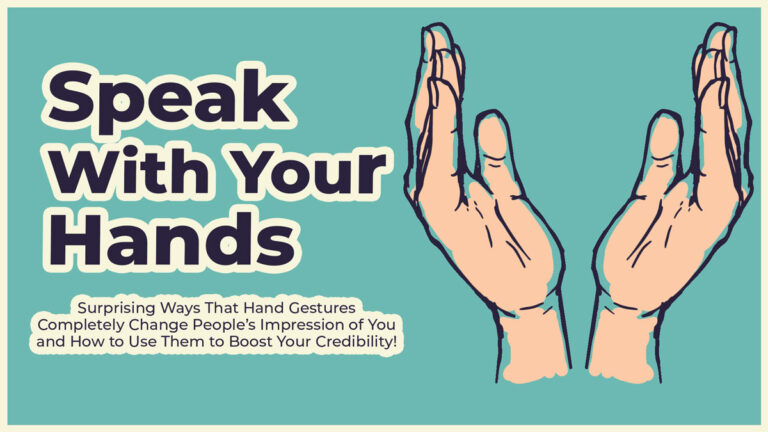Keeping your audience engaged throughout your presentation is necessary.
One effective way to achieve this is by mastering the art of pacing.
Pacing involves varying the speed and rhythm of your delivery to maintain interest, build suspense, or emphasise key points.
Here are 7 pacing changes you can apply, depending on the flow of your presentation, to keep your audience captivated:
1. Pause for Effect
Strategic pauses can be incredibly powerful.
They give your audience time to absorb what you’ve said, create suspense, or emphasise a point.
Use pauses before delivering important information to signal its significance or after a key point to let it resonate.
This silent beat can heighten the impact of your message and keep the audience hanging on to your next words.
For example, you’ve just shared a groundbreaking statistic that supports your argument.
After revealing the statistic, pause deliberately, allowing the number to sink in with the audience.
Your silence amplifies the importance and lets the audience absorb the weight of the information.

2. Accelerate to Excite
Speeding up your delivery can convey enthusiasm and passion, which can be contagious to your audience.
When you’re discussing exciting developments, breakthroughs, or revealing crucial outcomes, increasing your pace can pull your audience along at the height of your excitement.
This will keep them engaged and energised.
As an illustration, you’re leading up to the reveal of a successful project outcome.
As you build towards the climax, gradually increase your speaking pace.
This builds momentum and excitement, mirroring the crescendo of your narrative.
It keeps the audience on the edge of their seats.

3. Slow Down for Clarity
Slowing your pace when explaining complex ideas or important details can aid comprehension.
It gives the audience time to process the information.
It also helps them grasp the nuances of your argument or narrative.
Use a slower pace to ensure your audience can follow along and fully understand the critical parts of your presentation.
For instance, you’re explaining a complex concept or a detailed process.
Slow your pace significantly, articulating each word and pausing between sentences.
This gives the audience time to process each piece of information.
It ensures they grasp your message fully.

4. Vary Your Tone
Changing your vocal tone alongside your pacing can enhance the effect of your words.
A varied tone can convey different emotions and keep the audience interested in what you’ll say next.
Match your tone to your content:
- Use a warm and inviting tone for personal stories
- A Sharp and brisk tone for exciting news, or
- Steady and calm tone for serious information
Let’s say your presentation includes a transition from a serious topic to a more uplifting one. . .
Shift from a sombre, slow-paced delivery to a brighter, more energetic tone and pace as you transition topics.
This audibly cues your audience to the change and refreshes their attention.

5. Add Seconds of Silence
Silence can be a powerful tool in your pacing techniques.
It can create a dramatic effect, giving weight to what has been said or what will be said next.
Use silence to mark transitions between topics, to allow the audience to reflect, or to prepare them for a shift in the narrative or tone.
For example, you’ve just asked a rhetorical question or presented a challenging idea.
Follow your question or idea with a moment of silence, giving the audience time to ponder and engage mentally with the concept, creating a space for reflection.

6. Interactive Pacing
Engage your audience with questions, prompts, or short activities to break the monotony and inject energy into your presentation.
This interactive pacing change gives the audience a chance to participate actively, keeps their minds alert, and makes your presentation more memorable.
For example, the energy in the room is dwindling mid-presentation.
Inject a quick interactive element, like a poll or a thought-provoking question, inviting audience participation.
This shift in pace re-engages the audience, revitalising their attention and interest.

7. Use Visuals for Dynamic Pacing
Visuals like slides, videos, or live demos can change the pace and add excitement or emphasis to your presentation.
They provide a visual break from listening and can illustrate your points in a compelling way, adding depth to your words and providing a multi-sensory experience for the audience.
As an illustration, you’re about to explain a key part of your presentation that benefits from visual aids.
Introduce a compelling visual or video at the moment your verbal narrative needs reinforcement.
The visual element provides a pacing break, re-engaging the audience and enhancing their understanding through visual learning.

Make Your Message Memorable and Impactful
By skillfully applying these pacing changes, you can create a more dynamic, engaging, and effective presentation.
The key is to be mindful of your audience’s engagement and adapt your pacing accordingly, ensuring that your message is not only heard but truly resonates.
Remember, a well-paced presentation can transform passive listeners into active participants, making your message both impactful and memorable.


